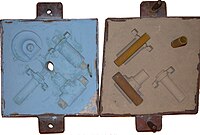
Photo from wikipedia
Abstract 3D printing sand mold technology offers an opportunity for the foundry industry to rethink old casting approaches and to revive the manufacturing approach using computer models. One of the… Click to show full abstract
Abstract 3D printing sand mold technology offers an opportunity for the foundry industry to rethink old casting approaches and to revive the manufacturing approach using computer models. One of the major concerns in sand molding using 3D printing is the functional characterization of the 3D printed molds as its mechanical and mass transport properties. This research paper discusses the effects of binder content on the mechanical strength and the permeability of 3DP sand molds at different curing conditions. The local permeability of the 3DP specimen was measured as a function of the injection flow rate in order to quantify the inertial pressure effects. The mechanical strength of the 3DP sand molds was characterized using traditional three-point bending strength measurements. The results show that the mechanical strength of the printed molds is deeply dependent on the amount of binder and the curing process. The 3PB strength was found to increase when cured at 100 °C and decrease when cured at 200 °C for all binder contents. The 3PB strength attains its maximum when cured at 100 °C for 2 h for all binder content. In contrast, no significant effect of the amount of binder on the initial permeability of the samples before curing was observed within the functional range of binder mass fraction (1.02–1.98 %). Maximum permeability is attained at the same conditions as the 3PB strength. Therefore, the mechanical strength of the sample can be optimized within the investigated range of binder contents without resulting in any significant decrease in permeability.
Journal Title: Journal of Manufacturing Processes
Year Published: 2019
Link to full text (if available)
Share on Social Media: Sign Up to like & get
recommendations!